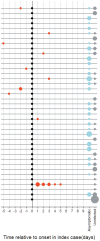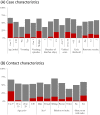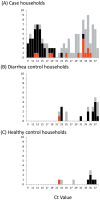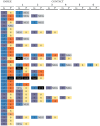Household transmission of rotavirus in a community with rotavirus vaccination in Quininde, Ecuador
- PMID: 23874443
- PMCID: PMC3706538
- DOI: 10.1371/journal.pone.0067763
Household transmission of rotavirus in a community with rotavirus vaccination in Quininde, Ecuador
Erratum in
- PLoS One. 2013;8(9). doi:10.1371/annotation/b1efd2d1-cc25-44c8-99e1-4bcdd3b8ccc8
Abstract
Background: We studied the transmission of rotavirus infection in households in peri-urban Ecuador in the vaccination era.
Methods: Stool samples were collected from household contacts of child rotavirus cases, diarrhea controls and healthy controls following presentation of the index child to health facilities. Rotavirus infection status of contacts was determined by RT-qPCR. We examined factors associated with transmissibility (index-case characteristics) and susceptibility (household-contact characteristics).
Results: Amongst cases, diarrhea controls and healthy control household contacts, infection attack rates (iAR) were 55%, 8% and 2%, (n = 137, 130, 137) respectively. iARs were higher from index cases with vomiting, and amongst siblings. Disease ARs were higher when the index child was <18 months and had vomiting, with household contact <10 years and those sharing a room with the index case being more susceptible. We found no evidence of asymptomatic infections leading to disease transmission.
Conclusion: Transmission rates of rotavirus are high in households with an infected child, while background infections are rare. We have identified factors associated with transmission (vomiting/young age of index case) and susceptibility (young age/sharing a room/being a sibling of the index case). Vaccination may lead to indirect benefits by averting episodes or reducing symptoms in vaccinees.
Conflict of interest statement
Figures





References
-
- Nelson EA, Glass RI (2010) Rotavirus: realising the potential of a promising vaccine. Lancet 376: 568–570. - PubMed
-
- Velazquez FR, Matson DO, Guerrero ML, Shults J, Calva JJ, et al. (2000) Serum antibody as a marker of protection against natural rotavirus infection and disease. J Infect Dis 182: 1602–1609. - PubMed
-
- Ruiz-Palacios GM, Perez-Schael I, Velazquez FR, Abate H, Breuer T, et al. (2006) Safety and efficacy of an attenuated vaccine against severe rotavirus gastroenteritis. N Engl J Med 354: 11–22. - PubMed
Publication types
MeSH terms
Substances
Associated data
- Actions
- Actions
- Actions
- Actions
- Actions
- Actions
- Actions
- Actions
- Actions
- Actions
- Actions
- Actions
- Actions
- Actions
Grants and funding
LinkOut - more resources
Full Text Sources
Other Literature Sources
Medical

